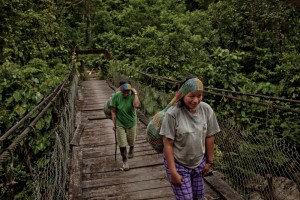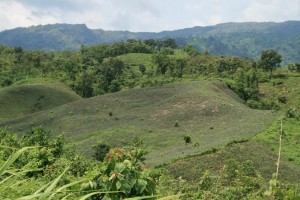Q&A with Fergus Sinclair, Systems Science Leader, World Agroforestry Centre (ICRAF)
 The Livelihood Systems project (Flagship 1) is the biggest research stream under the CGIAR Research Program on Forests, Trees and Agroforestry (FTA), making up 30% of the total FTA budget. Like the other CGIAR research programs, FTA is currently gearing up for the next phase. A “writeshop” in July in Bogor kick-started the pre-proposal drafting process. We asked Flagship 1 Coordinator Fergus Sinclair, a key figure in that process, to take stock of past achievements and give us an idea of the next research phase.
The Livelihood Systems project (Flagship 1) is the biggest research stream under the CGIAR Research Program on Forests, Trees and Agroforestry (FTA), making up 30% of the total FTA budget. Like the other CGIAR research programs, FTA is currently gearing up for the next phase. A “writeshop” in July in Bogor kick-started the pre-proposal drafting process. We asked Flagship 1 Coordinator Fergus Sinclair, a key figure in that process, to take stock of past achievements and give us an idea of the next research phase.
Q: What are the greatest challenges and achievements of the Livelihood Systems research so far?
A: By far the greatest challenge for research on livelihood systems over the first phase of the CGIAR Research Program on Forests, Trees and Agroforestry (FTA) has been making things work at scale. Millions of smallholders desperately need better access to quality tree seeds and seedlings, better management options and markets.
Current policies and institutions, as often as not, create barriers for smallholders, particularly women, that keep them from benefitting as much as they might do from tree and forest resources rather than enabling them to benefit. The key issue is reconciling participatory bottom up processes with the necessity of making an impact on the lives of millions of smallholders across millions of hectares of land. It is the old chestnut of balancing local and global action.

We have made great progress in developing an approach to ‘research in development’ that allows us, for the first time, to conduct systems research where we want to make an impact. This is exciting because it allows us to answer questions about the most effective ways to use tree and forest management approaches to improve the income and food security of large numbers of smallholders in many countries.
In the past, our research has been confined to small numbers of smallholders over small areas of land. We used participatory research to develop appropriate options for the communities we were working with – but it was difficult to scale out, because each new community required different options.
In contrast, development projects have large resources to work with lots of smallholders but tend to promote a few best bet options with little evidence available on what will work where and for whom. By embedding planned comparisons in development practice and using modern advances in remote sensing and crowd sourcing of data, we are now able to create solid evidence with development partners on what options suit different people and places.
We call this co-learning – because it involves coalitions of researchers, development practitioners, smallholders and the private sector who are in this together. Using planned comparisons to make learning efficient accelerates the impact of development spending.
Blog: One small change of words – a giant leap in effectiveness!
It is important to stress here that this approach cuts across our work on management options, markets and policy. Often policies are what constrains how smallholders can benefit from trees.
We were able to contribute greatly to improve smallholders’ income by legalizing their revenue from selling fast growing timber from fallow plots in the Peruvian Amazon. This required a change in how agroforestry was defined in national forest regulations to include temporal as well as spatial interactions between trees and farming and Flagship 1 research contributed to this change.
See Peruvian TV documentary Secrets of the Forest
We are making headway in getting people to move away from a one size fits all or silver bullet mentality and think about options of seeing trees in relation to the contexts they will ‘work’ for people. This leads to the promotion of tree diversity in fields, farms and landscapes.
Watch
Roots of recovery: trees, people and regeneration of the Sahel
Rediscovering our trees: promoting tree diversity in Lake Tanganyika basin
Q: Other Flagships also deal with smallholders’ realities and improving their lot. What are the differences between Flagship 1 and Flagship 2 (Management and conservation of forest and tree resources)?
A: As our name suggests, the smallholder livelihood systems research starts with the lives of smallholders – this is our focus. Our aim is to improve food security and income for the people in these households through better management of tree and forest resources that contribute to their livelihood.
Flagship 2 is concerned with forest management, starting from the perspective of managing ‘forests’ for multiple purposes that may include contributions to smallholder livelihoods but also includes other aspects such as conserving forest genetic resources, and meeting demand for timber. So the focus of Flagship 2 is different – it is on the ‘forest’ as a management unit rather than the household as a management unit.
Obviously, there are many ways in which researchers with these different perspectives need to interact, and there is rich scope for collaboration between the two Flagships.

In community forestry, for example, the Livelihood systems project looks at how different approaches impact smallholders. Controlling access to forest resources may be good for forest conservation but may make if difficult for some of the poorest people at the forest margin to gather firewood or food. How rules about forest access are made and applied affects not only how sustainably the forest is managed but also who benefits from it.
Appropriate community-based forest management can be an effective tool both for improving livelihoods and conserving forest, but getting this right is not easy and needs combined efforts from both a forest and a livelihood perspective – this is rarely achieved.
Blog: She who makes the rules wins!
Q: And what are the differences between Flagship 1 and Flagship 5 (Global governance, trade and investment)?
A: Again the differences between us and them stem from the focus. We look at value chains to the extent to which they represent opportunities for smallholders to improve their livelihoods locally, whereas Flagship 5 looks at how value chains operate globally from producer right through to the consumer with all the intermediaries that are involved.
Again there are important interactions between the two Flagships, for example in the development of certification schemes for cocoa (as well as timber, coffee and other products) that can result in smallholders gaining greater value from production systems that deliver public goods.
Blog: How many trees for a chocolate fix?
Another difference is that while Flagship 5 concentrates on selected value chains of global importance such as timber and oil palm, in our Flagship we also look at new and emerging products from agroforestry and a range of non-timber forest products (NTFPs) such as mushrooms or locally manufactured furniture. For example, there is now a margarine marketed by Unilever in Sweden made from Allanblackia oil, a tree recently domesticated through FP1 research).
We also have a private company in Viet Nam that has just signed a technology transfer agreement to market non-perishable products from the fruit of Son Tra (Docynia indica), an indigenous tree being promoted for agroforestry on sloping land in FP1 research, recently featured on Vietnamese television.
Q: What would be your idea for the next phase?
A: In the next phase, we anticipate that Flagships will be different and interactions between them will need to be stronger. In the pre-proposal just submitted, Livelihood Systems becomes Flagship 3, and will need to interact strongly with the two new Flagships on tree genetic resources (Flagship 2) and forest restoration and management (Flagship 4).We will continue to strengthen interactions with global value chain work under Flagship 5, with landscape scale impacts, the new Flagship 6, and with adaptation to climate change (Flagship 7).

This will include a strong focus together with Flagship 4 on farm timber. We hope to link a new emphasis on silvopastoral systems research with beef certification work in Flagship 5 (value chains). We also aim to consolidate our research on how field- and farm-level decisions about land use have an impact on ecosystem service provision at landscape scales with research under the new Flagship 6.
We will continue to consolidate links with the private sector, particularly with respect to research on smallholder production of tree-crop commodities, principally cocoa, coffee, rubber, oil palm and coconut.
A key role that trees play on farms is to improve and sustain soil health. We already know that trees promote large numbers of beneficial soil organisms but new advances in genomics allow us to look at functional profiles of below ground biodiversity supported by different tree species.
We look forward to combining genomics with local knowledge to develop agroforestry options that can address the 30% of Africa’s soils that are now non-responsive, that is crop yields are not increased even when fertilizers are applied because of poor soil health. As well as affecting microbial processes, trees interact in many other ways on farms, particularly through producing firewood, fodder and fruit. And we aim to use modelling of the roles of trees in sustainable intensification to develop options to improve smallholder livelihoods in different contexts.
Thank you for your time, Fergus.











